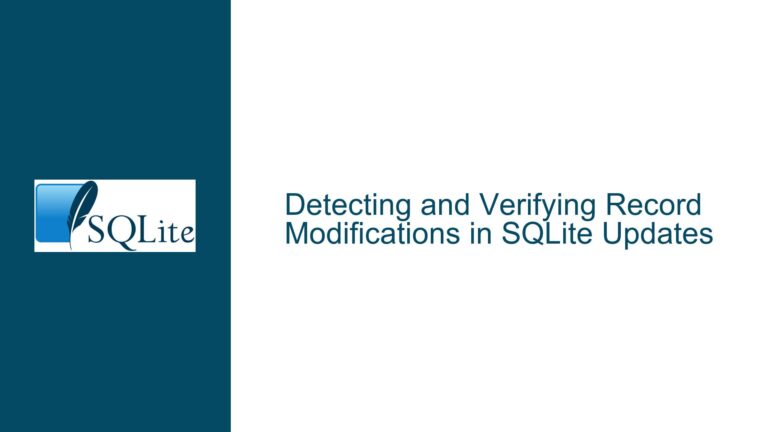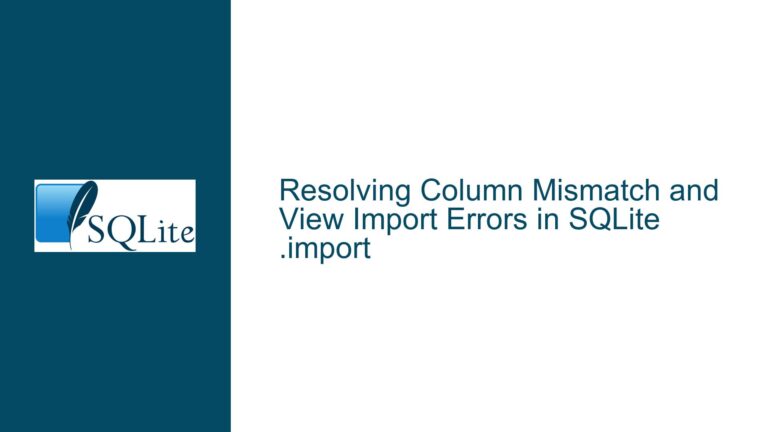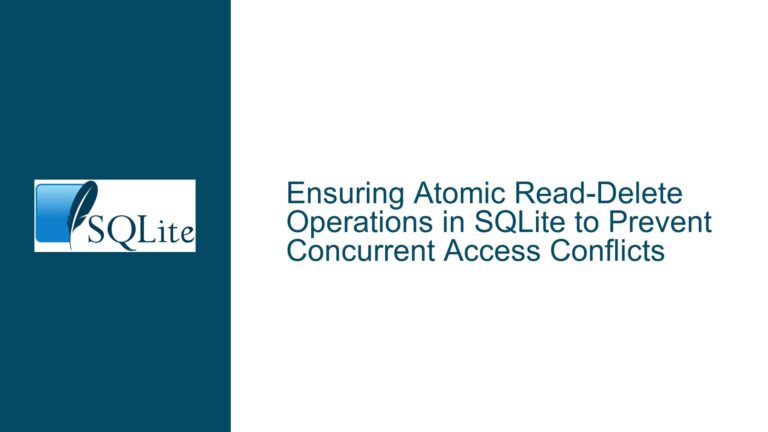SQLITE_FULL Error and Transaction Rollback Behavior in SQLite
SQLITE_FULL Error Occurrence During Transaction Execution
The SQLITE_FULL error is a critical error in SQLite that indicates the database has run out of storage space. This error typically occurs when SQLite attempts to allocate a new page in the database file but fails due to insufficient disk space or reaching the maximum file size limit. The error is raised immediately when the system detects the inability to allocate space, which often happens during the execution of an INSERT, UPDATE, or DELETE operation within a transaction.
A common misconception is that the SQLITE_FULL error would only occur during the commit phase of a transaction. However, SQLite is designed to detect and report errors as soon as they occur, rather than deferring them to the commit phase. This design choice ensures that the application is immediately aware of the issue, allowing it to handle the error appropriately without wasting resources on further operations that would ultimately fail.
When the SQLITE_FULL error occurs, SQLite automatically rolls back the transaction to ensure data consistency. This automatic rollback is a safety mechanism to prevent partial updates that could leave the database in an inconsistent state. However, this behavior can lead to confusion, especially when the application attempts to issue a COMMIT or ROLLBACK statement after the error has occurred. Since the transaction has already been rolled back internally, any subsequent attempt to COMMIT or ROLLBACK will result in a "no active transaction" error.
Causes of "No Active Transaction" and Database Locking Issues
The "no active transaction" error occurs because SQLite has already rolled back the transaction internally when the SQLITE_FULL error was encountered. This automatic rollback is a response to the catastrophic nature of the SQLITE_FULL error, which makes it impossible to commit the transaction. Once the transaction is rolled back, the connection no longer has an active transaction, and any attempt to COMMIT or ROLLBACK will fail with the "no active transaction" error.
The "database is locked" error, on the other hand, is a separate issue that can arise if the application does not properly handle the aftermath of the SQLITE_FULL error. When the SQLITE_FULL error occurs, the transaction is rolled back, but the database may remain locked if the application does not explicitly release the lock by issuing a ROLLBACK statement. This lock is a result of SQLite’s internal mechanisms to ensure data integrity during transactions. If the application attempts to start a new transaction without first resolving the lock, the "database is locked" error will occur.
The behavior of SQLite in this scenario can vary depending on the journal mode being used. In WAL (Write-Ahead Logging) mode, SQLite handles transactions differently compared to other journal modes like DELETE or TRUNCATE. WAL mode allows for concurrent reads and writes, which can complicate the handling of errors like SQLITE_FULL. However, the fundamental behavior of rolling back the transaction and requiring an explicit ROLLBACK to release the lock remains consistent across journal modes.
Resolving SQLITE_FULL Errors and Ensuring Proper Transaction Handling
To effectively handle SQLITE_FULL errors and avoid subsequent issues like "no active transaction" and "database is locked" errors, follow these steps:
Immediate Error Handling: When a SQLITE_FULL error occurs, the application should immediately stop any further database operations within the current transaction. This prevents additional errors and ensures that the application can focus on resolving the storage issue.
Check Transaction Status: After encountering the SQLITE_FULL error, the application should check whether a transaction is still active. This can be done using the
sqlite3_get_autocommitfunction, which returns a non-zero value if no transaction is active. If a transaction is still active, the application must explicitly issue a ROLLBACK statement to end the transaction and release any locks.Explicit Rollback: Even though SQLite automatically rolls back the transaction when a SQLITE_FULL error occurs, it is good practice to explicitly issue a ROLLBACK statement. This ensures that any locks held by the transaction are released, preventing the "database is locked" error when starting a new transaction.
Storage Management: The root cause of the SQLITE_FULL error is insufficient storage. The application should check the available disk space and the size of the database file to determine whether the error is due to a lack of disk space or reaching the maximum file size limit. If the issue is insufficient disk space, the application should free up space or move the database to a location with sufficient storage. If the issue is the maximum file size limit, consider splitting the database into smaller files or using a different storage solution.
Retry Logic: After resolving the storage issue, the application can retry the failed transaction. However, it is important to ensure that the retry logic is implemented carefully to avoid infinite loops or further errors. The application should also consider logging the error and notifying the user or administrator to prevent future occurrences.
Version Compatibility: Ensure that the application is using a recent version of SQLite. As noted in the discussion, some versions of SQLite may handle the SQLITE_FULL error and transaction rollback differently. Upgrading to the latest version can help avoid unexpected behavior and ensure that the application benefits from the latest bug fixes and improvements.
Testing and Monitoring: Regularly test the application’s handling of SQLITE_FULL errors and monitor the database for storage issues. Implementing proactive monitoring can help detect and resolve storage issues before they lead to SQLITE_FULL errors. Additionally, testing the application’s error handling logic can help identify and fix any issues before they occur in production.
By following these steps, you can effectively handle SQLITE_FULL errors and ensure that your application maintains data integrity and avoids locking issues. Proper error handling and storage management are key to maintaining a robust and reliable SQLite database.






